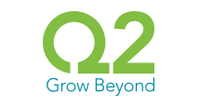Thursday, October 24, 2013
Q2's Quest To Enable Community Financial Institutions

In the world of banking, the rapidly changing world of technology is creating a new world for financial institutions, as customers no longer visit branches, but are accessing their banking institutions through their smartphone and tablet. That rapid change in technology has heavily impacted community financial institutions, who do not have the financial resources that big banks do to create and develop their own mobile apps and infrastructure. To that end, Austin's Q2 (www.q2ebanking.com) has set its sights to helping those community financial institutions keep up with the rapid pace of technology change, offering them full featured apps which let customers access those financial institutions' services via mobile, tablet, and desktop. We spoke with Matt Flake, the company's CEO, to learn more about the company and the world of community financial institutions.
For those who aren't aware of Q2, what do you do?

Matt Flake: Q2 provides virtual banking for community banks and credit unions. Essentially, we take all the features and experiences you can have in a branch, such as the ability to view your balance, transfer funds, or deposit a check, and give you the ability to do that via your mobile phone, desktop, or tablet, all in a secure environment. Our mission is the strengthen communities, by building better community financial institutions. We believe that in communities across this country, having community financial institutions drives growth in those communities, rather than having five big banks left in the country. We provide the technology to help those community financial institutions compete against the bigger financial institutions, such as Bank Of America.
Why is there a need for your software?
Matt Flake: If you look at what's been going over the last few years, and think about the world and how it's changed, it's changed drastically since Apple and Facebook have changed your expectations of how you use technology. Essentially, it has to be easy to use, and it has got to be ubiquitous. Whatever you do on your mobile phone, you want to be able to do on your tablet, and have that show up on your desktop. That has created a pressure on all industries, really, from healthcare, to financial services, to address what consumers need, because they're using all these devices all of the time. It's no different for community financial institutions. Consumers all have a mobile phone, and they want to be able to do banking on their mobile phone, and also on their tablet, and also the same thing on their desktop at work or at home. That pressure has manifested itself with community financial institutions, as well as the big banks. If you think about it, Bank of America used to have 10,000 branches around the country, and an ATM on every corner, but they've clearly stated they will be reducing their branch footprint, because they're using technology to get to customers, not branches. Community banks are worried about their branches. They're worried about that commercial on TV, which tells their customers to open an account with BofA and do all of their banking online.
What's happened, is there hasn't been lots of innovation in Fintech for the community financial institutions. We started ten years ago, and built a new platform which gives them the ability to interact with them from any device, whether that's a mobile phone, desktop, or tablet, and let them log in with the same login, password, and see all the same information, and set up things consistently. It's no different than a consumer expects from Netflix. If they go to their tablet, and set it up to see only documentaries, they want to pick up their mobile phone and only see documentaries, and see only documentaries on their desktop. No one else has built a platform to give them that. If they set up their banking to be in Spanish, it ought to be in Spanish across all those devices. They shouldn't have to set up all of them separately. We're revolutionizing what community financial institutions are able to do to compete against the likes of BofA, Wells Fargo, and others.
What's the story behind the company?
Matt Flake: From a talent perspective, if you look back to 1991, some of the folks here were building voice banking applications. If you think about what it was like in 1991, 1992, and 1993, you'd call your bank on the phone, to get them to do things like give you your balance or transfer funds. They started building voice banking back the, and then went on to build another company in 1996 and 1997 to take some of the first banks online. Then, in 2004, this business was started, to take information from back office systems, and present those to the user in an easy, fast, simple, and secure manner.. Our specialty is taking banking data, which is usually complicated and convoluted, and make it simple for the consumer to get information or conduct a transaction in a secure environment.
What's the biggest challenge facing the industry right now?
Matt Flake: Here's the biggest challenge facing everyone. If you think back 10, 20 years ago, the bank was one of those errands you'd run on a weekly basis. You'd go there to deposit checks, get cash, find financial advice, and all of that was part of your trip. However, as people began to get direct deposit, and there began to be ATMs on every corner, and debit cards became very popular, all of that technology has removed reasons to go into a branch. It just to happen that you might have a big check to deposit, and the branch would have you talk to someone in the trust department. Or, if you came in to deposit payroll, they'd start talking to you about your business and have you talk to someone in the business accounts area. What happens now, is people are just not going to the branch anymore. I believe it's no different than how Netflix has put Blockbuster out of business. The opportunity for community financial institutions, is that even if they're smaller, physically, they can offer personal services better than a branch. You have all the data that goes along with people when they grab their phone and drive to work, are on their desktop, or go home and grab their tablet. All of that information can help community financial institutions provide better product recommendations, solve problems for the consumer, all from a single platform. We have all that data, and we can sell their customers with products that are more relevant to where they are. If you have a seventeen year old son, we can go and offer a student loan to that person. Maybe they have a fifteen year old daughter, and they need a car loan. Maybe they're processing payments through Square, and are running a business, and might need a line of credit. All of that data is much more interesting, and allows them to provide personal service, so that they can outpace other companies, and innovate at the same pace as a Bank of America or Wells Fargo.
What's the next step for your company?
Matt Flake: There are really three things we're working on. One, is to unify the user experience, so that their mobile, tablet, and desktop are the same. With our next release, we'll have the full unified user experience. From that, we'll begin to drive things like more security. If you think about new technology, you realize that also comes with all the hackers and exposure to security issues, particularly when you're dealing with real money, which ones it leaves your account is gone. So, we're working to make our customers more secure. We're also driving more products that will help community financial institutions pick up more business, and provide more commercial banking functionality and analytics. We're going to be driving more analytics for banks and credit unions, so they can create a better product that their customers need.
Thanks!